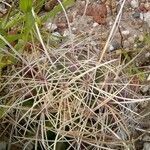Stems erect, spheric to short cylindric, 10-63 × 7.5-30 cm; ribs 10-17, crenate or sharply notched to undulate or deeply sinuate, hence ribs prominent to poorly defined, or stem sometimes tuberculate. Spines 12-16(-28) per areole, pinkish brown and/or straw colored, often imparting appearance of dried grass clump, smallest spines per areole slender, sometimes bristlelike, less than 1 mm diam.; central spines 4(-8) per areole, terete to strongly flattened, apically curved or strongly hooked, very flexible, sometimes almost papery, smooth to weakly annulate, principal central spine (40-)60-165 × (0.5-)1-3 mm. Flowers yellow inside and out, 5.5-8(-10) × 6.5-9.5 cm; inner tepals bright lemon yellow, very glossy; stigma lobes pale yellow. Fruits indehiscent, green or maroon, 20-50 × 10-30 mm, thin walled, soft, juicy, locule filled with very juicy pulp and seeds. Seeds 1-1.6 mm, pitted.
More
A cactus. Plants are usually single. They are round or cylinder shaped and 60 cm high by 30 cm across. There are 12-17 ribs. There are 4-8 central spines that are curved backwards and hooked at the tip. They can be twisted and are 8 cm long. There are 8-20 spines around these and they are straight and 1.5-8 cm long. The flowers are funnel shaped and yellow. They are 6-10 cm long. The fruit are oval and green to red. They are 2.5-5 cm long.
Xerophyllous scrub, on a diversity of soils and on hills, in soils from igneous rock and on old river gravels in the desert and grasslands.; at elevations up to 2,150 metres.
More
It is a tropical plant. It grows in dry and open areas.


